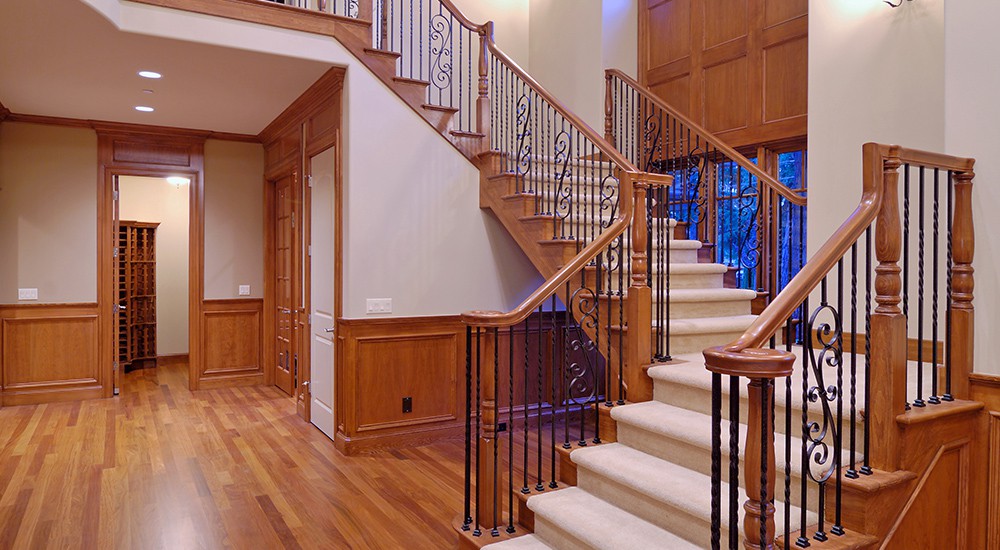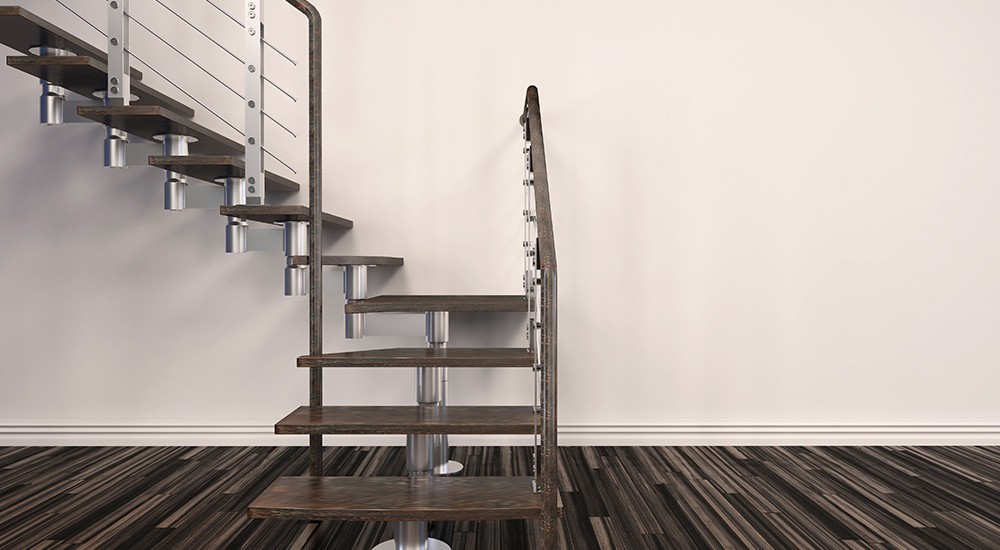Constructing wood stairs always brings up the hardwood vs. softwood for stair parts debate. In reality, the decision should be a simple one. Professionals can easily install wooden stairs using softwood or hardwood without much difference in results.
But there are distinct features that can influence your decision on which one to use for various stair parts. Here, we’ll discuss the intricacies of using either softwood or hardwood for stairs parts. Here’s all you need to know.
Hardwood vs. Softwood for Stairs Parts
One of the major importance of installing stairs is that it complements the look of the environment. Stairs comprise different parts which can be hardwood or softwood.
Although hardwoods are sturdier than softwoods, the major difference between them is the reproduction methods of their trees. Every tree produces seeds, but the seed type differs. Hardwood comes from angiosperm trees, while softwood is from a gymnosperm tree.
Another name for hardwood and softwood is deciduous for the former and evergreen for the latter. The former loses its leaves in the autumn, whereas evergreen trees retain their leaves, irrespective of the time of the year. While hardwood is generally harder than softwoods, that isn’t always the case.
For instance, balsa, one of the softest wood types, actually falls under the hardwood category. It further proves that hardwood and softwood are basically the same but have different growth patterns and other minor variations.
An example of hardwood is oakwood. Oak trees have a complex structure, and their growth method makes them part of the most durable wood types. On the other hand, softwood comes from trees like conifers. Unlike softwood, the complex nature of hardwood means it has a slower growth speed. As a result, softwood grows faster, allowing it to be in abundant supply.
Softwood stair parts have a slightly lesser price than hardwood because they’re easily accessible. The lesser cost of softwoods is one of the major advantages of using it in making stair parts. A lot of processes also go into manufacturing hardwoods, hence the higher cost.
Choosing Between Hardwood vs. Softwood for Stair Parts
The name implies that hardwood is generally sturdier, making it ideal for constructing stair parts, including stair treads. However, you can also use it for other stair parts, as it can also serve the same purpose.
Stair Treads
Stair treads are the horizontal portion of a set of stairs on which a person walks. Stair treads come in different materials, including metal, plastic, or other materials.
The sturdiness of hardwood makes it the ideal wood type for building stair treads. With oakwood being one of the best types of wood, most contractors use it for stair parts such as treads. But it all boils down to what you want as an individual.
People have different choices on how they want their house to look, and to get even better results; they have to select the right stairs parts, including the treads. Therefore, having what you want in mind for your home is essential in selecting the right wood type to complement the design.
Handrails Stair Parts
Rails are essential parts of stairs because they serve as support and guide at the side of the stairway or platform. Handrails make stairs safer as users can hold on to them while going upwards or downwards on the stairway.
Sometimes, stairs may become slippery making it dangerous for the elderly, people with disabilities, and young children. But with a handrail, the probability of such accidents happening will reduce greatly. Again, to highlight the importance of handrails, most states in Canada make it a legal requirement.
Your staircase must have a handrail, even if it’s just on one side and less than one meter. Asides from the safety function of a handrail, it also complements the appeal of your stairs. There are many handrail designs available, and in different materials too.
Wooden handrails are a great investment because of their durability and look. You can choose hardwood or softwood for constructing handrails as people don’t have to step on them like the stair treads. There are many wooden handrail designs that’ll serve as a stairway guide while also complementing the appeal of your home.
In other words, the type of wood you use for handrails doesn’t matter, so long as it serves its purpose. Likewise, the choice of hardwood or softwood for constructing the handrail doesn’t affect how long it’ll last. You just need to make sure the wood is strong enough to serve as a guide.
Balusters
Balusters are an important part of handrails that provide extra support to prevent kids falling through the gap between the threads and mills. Balusters consist of narrow spindles installed between the stair railings for vertical support. The major materials for balusters include wrought iron or wood.
Wooden stairs will most likely require wooden balusters to give it a finer look. Wooden balusters come in different forms like stain grade, imported primed conditions, or American-made primed.
During production, stain-grade balusters are manufactured and sanded properly for a stain or clear finish. These balusters are customizable, so you can get it any size to help you create your desired stair rail. At the same time, the tip American-made primed balusters are made with either poplar or soft maple to enable them to accept and hold paint properly.
You can also get American-made primed balusters in various sizes, shapes, and designs to complement the stairs’ handrails. The imported primed models are part of the best decisions you can make when searching for a better standard of balusters. Imported primed balusters are higher in standard and cost.
Many manufacturers use any type of wood for balusters, given that they serve the same purpose. Balusters can either be made in hardwood or softwood, and there are several designs you can select from for your stairs.
Risers
A stair riser is a vertical distance between one step and the next. Risers make it possible to move from one step to another in a descending or ascending manner. The riser element of a set of stairs consists of a board vertically installed at an angle of 90 degrees to the riser above and below. Risers are important because contractors use them in calculations to determine a comfortable and safe stairway design.
A rise and a riser in stairways are the same thing and serve the same purpose. But the former is intangible (open riser staircase), unlike the latter, which can comprise either hardwood or softwood. The popular materials used for making risers include poplar, maple, white oak, or pine.
From a botanical perspective, poplars are angiosperms, making them suitable hardwood for stair risers. White oak is another hardwood that’s ideal for riser stairs parts.
Maple is originally a hardwood, but it has a softwood variant which is known as sugar maple. Maple wood is also a very good option to consider for stair risers. Whatever the case may be, you can either use hardwood or softwood for stairway risers.
Related Article: 25 Hardwood Stairs Design Ideas
Stringer Parts

A stringer is a vertical board that runs along both sides or at the center of a stairway to provide support. The treads and risers are fixed into the stringer. In other words, a stringer is the platform that carries other parts of a stairway.
Stringers can come from either hardwood or softwood. Plus there are different types of stringers available for stairway construction. Each of these types of stringers gives your staircase different unique looks to make it more appealing.
Have a look at the different types of stringers below.
Center Beam Stringer
The center beam stringer is located in the middle, and as the name suggests, it’s a strong form of support that holds your stairway in position. It gives the stairway a unique design that makes the look of your home or office unforgettable. However, you’ll mostly find a center beam stringer stairway design in offices, hotels, and other outdoor places like a lounge or a club.
Center beam stringers can comprise hardwood or softwood. But you’ll need to liaise with the contractor to get a better hint on what wood type to use, depending on the size and length of the stairs.
It’s better to install wooden center beam stringers in areas with less traffic. You can install a stairway with a wooden center beam stringer in your home to give it an elegant look. But it’s not suitable for raising toddlers.
The stairway design with a wooden center beam stringer gives room for little spaces in between the stairs. Toddlers are more likely to have accidents in those little spaces and sustain injuries without proper guidance.
Residential Stair Stringer
Residential stair stringers are the safest stairway framework and suitable for almost every environment.
Twin Stringer
A twin stringer is usually placed 6 inches apart under the middle of the stairs. However, the contractor can also place the twin stringers off-center, i.e., close to the edge of the treads, to give a more striking appeal.
Twin stringers are ideal for offices and modern residences. They’ll help you achieve an open and contemporary look. However, you may have to reinstall a twin stringer after a long while because it can start bending over time.
Cantilevered Stringer
A cantilevered stringer, also known as a single side stringer, is set up and reinforced in the stairway wall. In other words, a cantilevered stringer comprises one side of the treads fixed into the stairway wall, leaving the other side open. This type of stringer gives the environment an elegant look and a stunning architectural effect.
In building cantilevered stringers, the treads can be either hardwood or softwood but must be thick enough and have good quality. In addition, the treads need to be quite strong enough to carry weight since it gets support from only one side.
Closed Stringer
Closed stair stringers are the safest to use in homes, commercial structures, and offices. Also, this type of stringer is useful for outdoor stairs. But you can also have a fancier closed stringer installed in your home.
When it comes to closed stair stringers, the treads and risers are fixed in the middle. The closed stringer encloses the treads and risers on both sides. However, you can decide to build your stairway without risers when you select a closed stringer design.
It’s also easier and budget-friendly to build a closed stringer. There are many precut designs available to select from to build a beautiful closed stringer stairway.
Open Stringer
Open stringers are also known as sawtooth or cut stringers. When you view open stringers from the side, you’ll see the wooden treads protruding from the edge. If you wish to install an open stringer, have it in mind that the balustrade supporting the rails will be directly on top of the treads.
There’s no need to select from hardwood vs. softwood for open stair stringer parts. Your choice is wood doesn’t matter. As long as it’s quality wood, it’ll do the job.
Hardwood vs. Softwood for Stair Parts: Which is Better?

There are different forms of construction projects, and they require different kinds of wood. Hardwood and softwood are both suitable for anything from structural to decorative purposes.
The difference between these wood types doesn’t affect their usefulness in constructing stair parts.
The differences between hardwood and softwood is based on biological characteristic, with hardwood being an angiosperm product and softwood, gymnosperm. Angiosperm trees take more time to develop, and that’s why hardwood may cost more than softwood. Softwood, being a gymnosperm, is evergreen. It has a rapid growth rate, hence its availability.
So, for your stair parts, you can go on to use either hardwood or softwood for construction. You just need to know the exact type you want and why you want it. To better guide your decision, it’s better to use hardwood for surfaces due to their sturdiness.
Related Article: How to Install Hardwood Stairs
Final Thought
People tend to think that hardwood is more efficient than softwood, as their names imply, But that’s not the case. The major difference between hardwood and softwood doesn’t affect their durability and efficiency, making both wood types ideal for stair parts construction.
You can check our online store for different types of stair parts to beautify your home. Here at LV Flooring, our products have the best quality and are also pocket-friendly. Let’s help you make the right stair parts choice!


